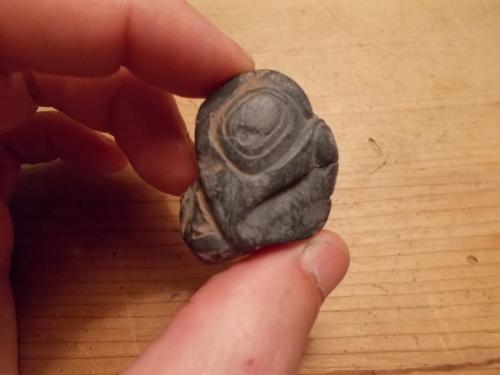
NW Coast stone carving found in Chumash Territory, California. Source: http://www.arrowheadology.com/forums/showthread.php?t=42646&p=359269&viewfull=1#post359269
If someone out there in webland makes a link to my blog, and then someone else clicks on that link, I might be able to tell which site is referring to me. Sometimes this leads to unexpected discoveries. One of these incoming links is a query to an artifact collecting forum (boo) from a collector in southern California, who found the above small sculpture in Chumash territory. As is so common in the collector world, there is no other contextual information about this piece, which to my eye, appears to be an early historic Haida carving in argillite. Knowledgeable readers may wish to weigh in below in the comments section about the motifs and provenance of this sculpture – there are more fairly low-quality pictures here. How it made its way to the Santa Barbara area is anyone’s guess, it may have been a simple curio bought by a tourist, or it may be a now-lost bit of evocative human history like the one I suggested here for Haida argillite found on San Juan Island.

NW Coast stone carving found in Chumash Territory, California. Source: http://www.arrowheadology.com/forums/showthread.php?t=42646&p=359269&viewfull=1#post359269


If it is argillite it would have to have come from the Haida as only Haida artists can carve that stone, so I doubt it came from Alaska or Washington. Probably trade item.
LikeLike
The pot hunter site “looking for like minded people to hunt with” — uhhhhh!!!! Describes this as steatite and I must say it looks to me more like that stone than argillite. If so, this broadens the geographic and ethnic reange of possibilities, but the style does look very northern to me. Lots of fur trade ships stopping at Monterey (same area?) to load up on abalone shells to trade with the Haida and other NWC peoples. I am sure there was some shuttle voyaging that could explain this ending up down there.
LikeLike
I see with a quick Google Earth check that Santa Barbara is some 300 km from Monterrey but the general comment holds still I think. Gee, California is a big place 😉
LikeLike
The Channel Islands in Chumash territory are known for their abalone stocks, I believe.
Is North Coast steatite carving very common?
the picture isn’t good enough to say, but the one piece of argillite I’ve found in the ground in Haida Gwaii had a pitted deep grey surface not unlike this one vs. the shiny black polished look of better curated pieces (compare to the one I linked from San Juan Island.
Cristal – thanks for your comment and agreed that if it is argillite then essentially must be Haida. Argillite generically is a fairly common rock type including lots on Haida Gwaii, but the carving argillite is, as far as I know, limited to a single source not far from Skidegate.
I wonder if anyone has chemically characterized the Slatechuck source?
This piece looks like an elbow pipe but I feel like the collector/looter would have noted if it had been drilled for that purpose.
LikeLike
What is the problem here the Haida where known to trade as far down the coast as Fort Ross CA. The Russians have made notes about “2 haida in canoe rounding the point to trade” so what is the problem with the Haida going the rest of the way down the coast? My people have many stories of long canoe voyages, what can only european explorers and traders go that far? The easiest way to confirm this is to have a knowledgeable person identify the stone.
LikeLike
Hi Robert, thanks for your comment. I don’t think it’s a problem exactly, it’s more like, this thing was looted and therefore we may have lost valuable clues as to how and when it made its way south. Could well have been as you described, it could have been more of a “down the line” trading, it could have been taken on a trading ship by a sailor or traveller. One thing to keep in mind is, in the early European accounts of the coast, they often seem to have used “Haida” as a generic term for Northern coast First Nations. Not sure why, easier to spell maybe :), as well as the wide-ranging presence of the Haida themslevesof course.
I agree it would be great to have someone knowledgeable identify the stone and the designs.
LikeLike
Chumash fine arts included baskets, sea animals carved in wood and soapstone, and, from roughly 1000 to 1800, ceremonial rock paintings. The latter were generally abstract but also contained highly stylized life forms.
LikeLike
The origin is certainly NWC.
Why is the object ‘looted’?
I would certainly be interested to buy it, if available.
Best, Alex
LikeLike